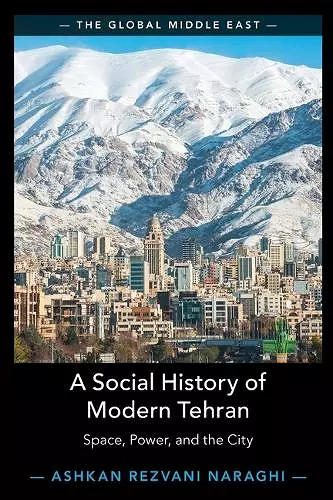A Social History of Modern Tehran
Space, Power, and the City
Format:Paperback
Publisher:Cambridge University Press
Published:5th Jun '25
Currently unavailable, and unfortunately no date known when it will be back
This paperback is available in another edition too:
- Hardback£94.00(9781009188890)

Outlines how Tehran's social spaces were transformed by shifting discourses and practices from the nineteenth to the mid-twentieth century.
Telling the history of Tehran from the nineteenth to the mid-twentieth century, Ashkan Rezvani Naraghi demonstrates how the city was transformed by developing discourses around spatial knowledge. Using an array of archival sources, Rezvani Naraghi stresses the agency of everyday inhabitants in the process of urban change.Tehran, the capital of Iran since the late eighteenth century, is now one of the largest cities in the Middle East. Exploring Tehran's development from the nineteenth to the mid-twentieth century, Ashkan Rezvani Naraghi paints a vibrant picture of a city undergoing rapid and dynamic social transformation. Rezvani Naraghi demonstrates that this shift was the product of a developing discourse around spatial knowledge, in which the West became the model for the social practices of the state and sections of Iranian society. As traditional social spaces, such as coffee houses, bathhouses, and mosques, were replaced by European-style cafes, theatres, and sports clubs, Tehran and its people were irreversibly altered. Using an array of archival sources, Rezvani Naraghi stresses the agency of everyday inhabitants in shaping urban change. This enlightening history not only allows us to better understand the contours of contemporary Tehran, but to develop a new way of imagining, talking about, and building 'the city'.
'In this meticulous and careful study, Tehran is no longer just a setting or even a contested site, but an almost living creature that shares in and shapes its inhabitants' lives and social transformations over time. This book is a gift from an insightful colleague who, though lost to us now, invites us to revisit our own work with fresh eyes and prods us towards new and productive lines of inquiry.' Camron Michael Amin, University of Michigan-Dearborn
'This book is a seminal analysis of the role of Tehran in Iran's social history. Based on a valuable array of primary material, it provides a unique window into the human and physical geographies of the capital during the turbulent social transformations of the first part of the twentieth century. A refreshing addition to our understanding of modern Iran.' Siavush Randjbar-Daemi, University of St Andrews
'This book is an incredibly rich mine of information for anyone interested in social history. As a scholar working on political contention and mobilizations, I appreciated Naraghi's mastery in explaining that the socially embedded knowledge of how and where to protest builds upon existing spatial practices of communal life and how such knowledge has changed across the decades as a reflection of the meaning of 'living together'. Intertwining cultural history, human and political geography, economic, gender, and class analysis, [this] is a must-read for any scholar interested in Iran and an extremely beneficial reading for social scientists in general.' Paola Rivetti, American Historical Review
ISBN: 9781009188913
Dimensions: unknown
Weight: unknown
488 pages